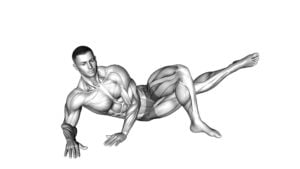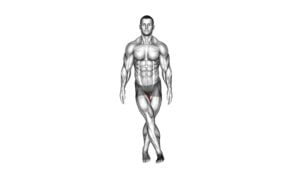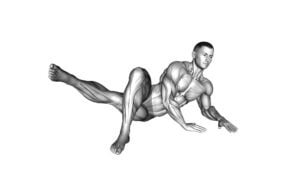Hip – Adduction – Video Exercise Guide & Tips

In this video exercise guide, you'll learn all about hip adduction and how to perform it correctly. With the right form and technique, you can reap the benefits of this effective workout.
Watch This Exercise Video
Whether you're a beginner or looking for advanced variations, we've got you covered. Plus, we'll share tips to help you progress and maximize your results.
Get ready to take your hip adduction workouts to the next level with our expert tips and instructional videos.
Key Takeaways
- Regularly performing hip adduction exercises maximizes benefits for lower body strength and stability.
- Improving hip stability is crucial for overall lower body function and preventing hip injuries.
- Hip adduction exercises target the adductor muscles responsible for stabilizing the hip joint.
- Incorporating hip adduction exercises strengthens the adductor muscles and improves hip joint stabilization.
Benefits of Hip Adduction Exercises
You should regularly perform hip adduction exercises to maximize the benefits for your lower body strength and stability. Improving hip stability is crucial for overall lower body function and preventing hip injuries. Hip adduction exercises specifically target the muscles responsible for stabilizing the hip joint, such as the adductor muscles. These exercises involve bringing your legs together towards the midline of your body.
By regularly incorporating hip adduction exercises into your workout routine, you can strengthen the adductor muscles and improve their ability to stabilize the hip joint. Stronger hip stabilizers can help prevent common hip injuries, such as strains and sprains. Additionally, these exercises can also enhance your overall lower body strength, as the adductor muscles play a significant role in movements like squatting and lunging.
Some examples of hip adduction exercises include seated hip adductions, standing hip adductions with a resistance band, and side-lying leg lifts. It's important to start with lighter resistance or bodyweight and gradually increase the intensity as your strength improves. As with any exercise, it's crucial to maintain proper form and listen to your body to avoid overexertion and potential injury.
Incorporating hip adduction exercises into your regular workout routine can help improve hip stability and prevent hip injuries. Remember to consult with a healthcare professional or certified trainer to ensure you're performing the exercises correctly and safely.
Proper Form and Technique for Hip Adduction
To achieve proper form and technique for hip adduction, utilize a moderate resistance level and focus on engaging the adductor muscles throughout the movement. Here are some tips to help you perform hip adduction exercises correctly:
- Position yourself correctly: Sit on the hip adductor machine with your back straight and feet resting on the foot pads. Adjust the pads so that they're positioned just above your knees.
- Maintain proper posture: Keep your core engaged and your upper body stable throughout the exercise. Avoid slouching or leaning forward.
- Control the movement: Slowly bring your legs together by squeezing your inner thighs. Avoid using momentum or jerking motions.
- Breathe properly: Inhale as you open your legs and exhale as you bring them back together.
- Common mistakes to avoid: One common mistake is using too much weight, which can lead to poor form and potential injury. Another mistake is relying on momentum rather than focusing on the targeted muscles.
- Common misconceptions: Some people believe that hip adduction exercises can spot-reduce fat on the inner thighs. However, spot reduction isn't possible, and these exercises primarily strengthen and tone the adductor muscles.
By following these tips, you can ensure proper form and technique during hip adduction exercises.
Now, let's explore the best equipment for hip adduction workouts.
Best Equipment for Hip Adduction Workouts
Now let's explore the ideal equipment to enhance your hip adduction workouts.
When it comes to hip adduction exercises, there are two main types of equipment that can be highly beneficial: hip adduction machines and resistance bands.
Hip adduction machines are specifically designed to target and strengthen the muscles involved in hip adduction. These machines typically consist of a seat and a set of pads or levers that you can position against your inner thighs. By pushing your legs together against the resistance provided by the machine, you can effectively work your hip adductors. One advantage of using a hip adduction machine is that it allows you to easily adjust the resistance level to suit your fitness level and goals.
Resistance bands are another great option for hip adduction workouts. These elastic bands come in various levels of resistance, allowing you to gradually increase the challenge as you get stronger. To perform hip adduction exercises with resistance bands, simply secure the band around your legs, just above your knees, and then push your legs together against the resistance. Resistance bands are lightweight, portable, and versatile, making them a convenient option for both home and gym workouts.
Both hip adduction machines and resistance bands can be effective tools for targeting and strengthening your hip adductors. Choose the equipment that best suits your preferences and fitness level, and remember to always use proper form and technique to maximize the effectiveness of your workouts.
Advanced Variations of Hip Adduction Exercises
Explore advanced variations of hip adduction exercises to challenge and strengthen your hip adductors even further. These modifications will take your workout to the next level and help you maximize your results. Here are some advanced variations to consider:
- Resistance band hip adduction: Attach a resistance band around your legs, just above your knees. Stand with your feet hip-width apart and slightly bend your knees. Slowly squeeze your knees together against the resistance of the band, engaging your hip adductors. Hold for a few seconds and then release.
- Single-leg hip adduction: Stand with one leg slightly lifted off the ground and the other leg firmly planted. Slowly bring the lifted leg across your body, towards the midline, engaging your hip adductors. Hold for a few seconds and then return to the starting position. Repeat on the other side.
- Side plank with hip adduction: Start in a side plank position, with your forearm on the ground and your body in a straight line. Lift your top leg and bring it across your body, engaging your hip adductors. Hold for a few seconds and then return to the starting position. Repeat on the other side.
When performing these advanced variations, it's important to be aware of common mistakes. Avoid using momentum or swinging your legs, as this takes away from the effectiveness of the exercise. Focus on slow, controlled movements and maintain proper form throughout.
Remember to consult with a professional trainer or healthcare provider before attempting any advanced modifications to ensure they're suitable for your fitness level.
Tips for Progressing and Maximizing Results
To continue progressing and maximizing your results, focus on incorporating these tips into your hip adduction exercises. By utilizing proper progression techniques and optimizing muscle activation, you can take your workouts to the next level.
One effective way to progress your hip adduction exercises is by increasing the resistance. Start with a weight that challenges you but allows you to maintain proper form. As you become stronger, gradually increase the weight to continue challenging your muscles and promoting growth. You can also try incorporating resistance bands or ankle weights to add variety and intensity to your workouts.
Another progression technique is to increase the number of repetitions or sets. As you get more comfortable with the exercise, aim to add an extra set or increase the number of repetitions you perform. This will help to increase the overall volume of work being done, leading to greater muscle stimulation and growth.
To maximize muscle activation during hip adduction exercises, focus on engaging the target muscles throughout the entire range of motion. Avoid using momentum or relying on other muscle groups to assist you. Instead, concentrate on contracting your adductor muscles as you bring your legs together and control the movement on the way back.
Incorporating these progression techniques and optimizing muscle activation will help you continue to challenge your body and achieve optimal results from your hip adduction exercises. Remember to listen to your body and progress at a pace that's comfortable for you, and always consult with a fitness professional if you have any concerns or questions.
Frequently Asked Questions
Are There Any Precautions or Contraindications for Performing Hip Adduction Exercises?
Before you start performing hip adduction exercises, it's important to be aware of any precautions or contraindications.
Precautions are measures you should take to prevent potential risks or injuries.
Contraindications, on the other hand, are conditions or situations in which performing the exercise may be harmful or not recommended.
It's always a good idea to consult with a healthcare professional or a qualified fitness instructor to ensure that these exercises are suitable for you and your specific needs.
How Often Should Hip Adduction Exercises Be Performed for Optimal Results?
To achieve optimal results from hip adduction exercises, it's important to perform them with the right frequency. By consistently incorporating these exercises into your routine, you can maximize their benefits.
Regularly engaging in hip adduction exercises helps strengthen the muscles in your hips, improves stability, and enhances overall lower body strength.
It's recommended to consult with a fitness professional to determine the optimal frequency of hip adduction exercises based on your individual fitness goals and current level of fitness.
Can Hip Adduction Exercises Help With Specific Hip Imbalances or Dysfunctions?
Hip adduction exercises can be beneficial for athletes and runners who've specific hip imbalances or dysfunctions. By targeting the muscles responsible for hip adduction, these exercises can help improve stability, balance, and overall hip function.
They can also help correct any imbalances or weaknesses in the hip muscles, which can lead to improved performance and reduced risk of injuries. Incorporating hip adduction exercises into your training routine can be a valuable addition for addressing specific hip issues.
Is It Normal to Feel Discomfort or Soreness in the Hip Muscles After Performing Hip Adduction Exercises?
Feeling discomfort or soreness in your hip muscles after doing hip adduction exercises is normal. These exercises are designed to strengthen your inner thighs, and it's common to experience some muscle soreness as they're being worked.
To reduce discomfort, make sure you warm up properly before starting the exercises and gradually increase the intensity. It's also important to maintain proper form and listen to your body's limits.
If the discomfort persists or becomes intense, it's best to consult with a healthcare professional.
Are There Any Modifications or Alternatives for Individuals Who Experience Knee Pain During Hip Adduction Exercises?
If you experience knee pain during hip adduction exercises, there are modifications and alternatives you can try. It's important to listen to your body and not push through the pain.
Instead of performing traditional hip adduction exercises, you can focus on exercises that strengthen the hip muscles without putting strain on the knees, such as lateral leg raises or clamshells.
These exercises can still target the hip muscles effectively while reducing the risk of knee pain.
Conclusion
In conclusion, hip adduction exercises are a great way to strengthen the muscles in your hips and improve overall lower body stability.
By using proper form and technique, along with the right equipment, you can maximize the benefits of these exercises.
Additionally, advanced variations can be incorporated to challenge yourself further.
Remember to progress gradually and listen to your body to avoid injury.
With consistency and dedication, you can achieve great results from hip adduction workouts.

Author
Years ago, the spark of my life’s passion ignited in my mind the moment I stepped into the local gym for the first time. The inaugural bead of perspiration, the initial endeavor, the very first surge of endorphins, and a sense of pride that washed over me post-workout marked the beginning of my deep-seated interest in strength sports, fitness, and sports nutrition. This very curiosity blossomed rapidly into a profound fascination, propelling me to earn a Master’s degree in Physical Education from the Academy of Physical Education in Krakow, followed by a Sports Manager diploma from the Jagiellonian University. My journey of growth led me to gain more specialized qualifications, such as being a certified personal trainer with a focus on sports dietetics, a lifeguard, and an instructor for wellness and corrective gymnastics. Theoretical knowledge paired seamlessly with practical experience, reinforcing my belief that the transformation of individuals under my guidance was also a reflection of my personal growth. This belief holds true even today. Each day, I strive to push the boundaries and explore new realms. These realms gently elevate me to greater heights. The unique combination of passion for my field and the continuous quest for growth fuels my drive to break new ground.







